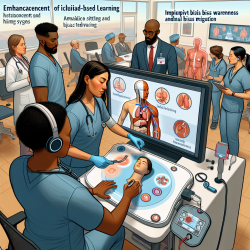Introduction
Implicit biases in healthcare can significantly affect patient outcomes, particularly for marginalized communities. A recent study titled "Using Simulation-Based Learning with Standardized Patients (SP) in an Implicit Bias Mitigation Clinician Training Program" explores an innovative approach to address these biases. This blog delves into how practitioners can leverage these findings to improve their clinical skills and outcomes for patients.
Understanding the Study
The study, conducted at an academic medical center, aimed to develop a clinician training program focused on implicit bias recognition and management. It involved medical residents and Doctor of Nursing Practice students in a two-session training program. The program included:
- Didactic sessions on healthcare disparities, racism, and implicit bias.
- Implicit Association Tests (IATs) to raise awareness of personal biases.
- Skill-building for bias-mitigating communication.
- Simulation-based encounters with standardized patients (SPs) from the local community.
Key Findings and Improvements
The initial trial enrolled 65 participants and revealed several insights:
- Participants reported discomfort with the intensive sequencing of sessions, prompting a restructuring to separate didactic sessions from IAT administration and SP simulations.
- Community partners and SPs highlighted the need for greater faculty support during debriefings to balance power dynamics.
- The program was refined to include more interactive discussions on identity, race, and ethnicity, and strategies to address local health system challenges.
Implications for Practitioners
For practitioners looking to enhance their skills, the study underscores the importance of:
- Engaging in simulation-based learning to practice and refine communication skills in a safe environment.
- Participating in interactive discussions to deepen understanding of implicit biases and their impact on patient care.
- Collaborating with community members to tailor training content to address local patient population needs.
By incorporating these elements into training programs, practitioners can better recognize and mitigate implicit biases, ultimately improving patient outcomes.
Encouraging Further Research
While the study provides a solid foundation for implicit bias mitigation training, further research is needed to measure the success and impact of replicating this approach in different settings. Practitioners are encouraged to explore how these findings can be adapted and applied in their own clinical environments.
Conclusion
The study demonstrates the potential of simulation-based learning with standardized patients to enhance clinician skills and mitigate implicit biases. By fostering a deeper understanding of biases and improving communication skills, practitioners can contribute to more equitable healthcare outcomes.
To read the original research paper, please follow this link: Using Simulation-Based Learning with Standardized Patients (SP) in an Implicit Bias Mitigation Clinician Training Program.










